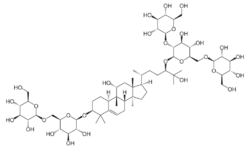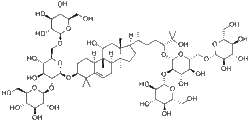Chemistry:Mogroside
A mogroside is a glycoside of cucurbitane derivatives found in certain plants, such as the fruit of the gourd vine Siraitia grosvenorii (known as monkfruit or luohan guo).[1][2] Mogrosides are extracted from S. grosvenorii and used in the manufacture of sugar substitutes.[1][2]
Mogrosides
Mogrosides include:[1][2][failed verification][citation needed]
- Mogrol
- Mogroside II A1
- Mogroside II B
- 7-Oxomogroside II E
- 11-Oxomogroside A1
- Mogroside III A2
- 11-Deoxymogroside III
- 11-Oxomogroside IV A
- Mogroside V
- 7-Oxomogroside V
- 11-Oxo-mogroside V
- Mogroside VI
- Siamenoside I
Mogroside V is the main component of Siraitia grosvenorii fruit, constituting 0.5% to 1.4% of the dried fruit.[citation needed][3]
Biosynthesis
One analysis of 200 candidate genes of Siraitia grosvenorii revealed five enzyme families involved in the synthesis of mogroside V: squalene epoxidases, triterpenoid synthases, epoxide hydrolases, cytochrome P450s, and UDP-glucosyltransferases.[1] The metabolic pathway for mogroside biosynthesis involves an initial stage of fruit development when squalene is metabolized to di-glucosylated, tetra-hydroxycucurbitadienols, then during fruit maturation, branched glucosyl groups are added and catalyzed, leading to the sweet M4, M5, and M6 mogrosides.[1]
Stability
Mogroside V appears to be heat stable in the range of 100 to 150 degrees Celsius for 4 hours and up to 8 hours in boiling water. It is stable at a pH of between 3 and 12 when stored from 2 to 8 degrees Celsius.[4]
Uses
Some mogrosides are used in traditional Chinese medicine[2] and some are extracted for manufacturing as sweeteners.[1] Mogroside V extract from S. grosvenorii fruit is 250 times sweeter than sucrose,[1] sold commercially in Norbu (sweetener).
References
- ↑ 1.0 1.1 1.2 1.3 1.4 1.5 1.6 Itkin, M.; Davidovich-Rikanati, R.; Cohen, S.; Portnoy, V.; Doron-Faigenboim, A.; Oren, E.; Freilich, S.; Tzuri, G. et al. (2016). "The biosynthetic pathway of the nonsugar, high-intensity sweetener mogroside V from Siraitia grosvenorii". Proceedings of the National Academy of Sciences of the United States of America 113 (47): E7619–E7628. doi:10.1073/pnas.1604828113. PMID 27821754.
- ↑ 2.0 2.1 2.2 2.3 Subhuti Dharmananda (January 2004), "Luo han guo - Sweet fruit used as sugar substitute and medicinal herb". Institute for Traditional Medicine, Portland, Oregon.
- ↑ "Chemistry and pharmacology of Siraitia grosvenorii: a review". Chinese Journal of Natural Medicines 12 (2): 89–102. 2014. doi:10.1016/S1875-5364(14)60015-7. PMID 24636058.
- ↑ Younes, Maged; Aquilina, Gabriele; Engel, Karl‐Heinz; Fowler, Paul; Frutos Fernandez, Maria Jose; Fürst, Peter; Gürtler, Rainer; Gundert‐Remy, Ursula et al. (11 December 2019). "Safety of use of Monk fruit extract as a food additive in different food categories". EFSA Journal 17 (12). doi:10.2903/j.efsa.2019.5921. PMID 32626208.
External links
 |




